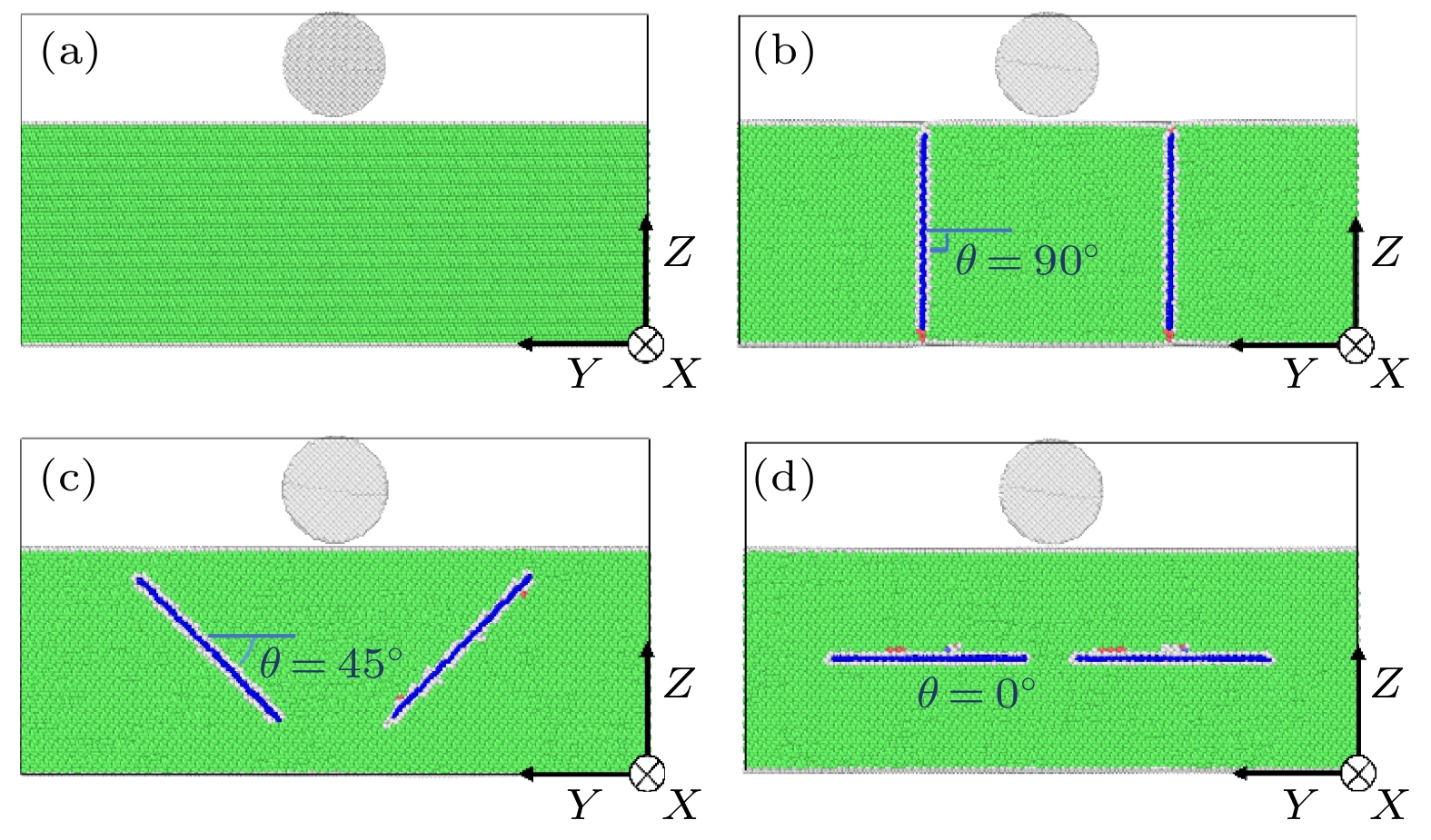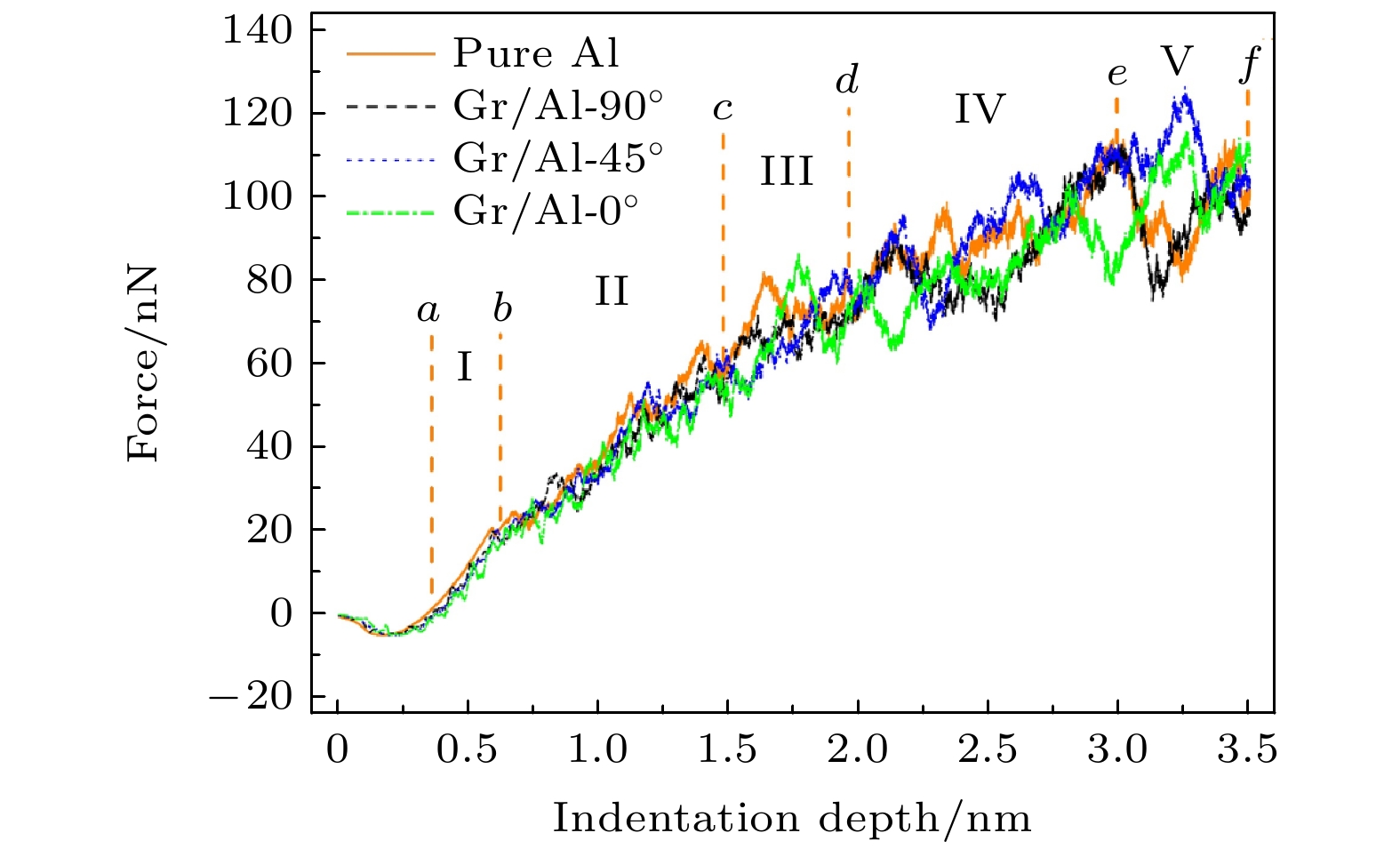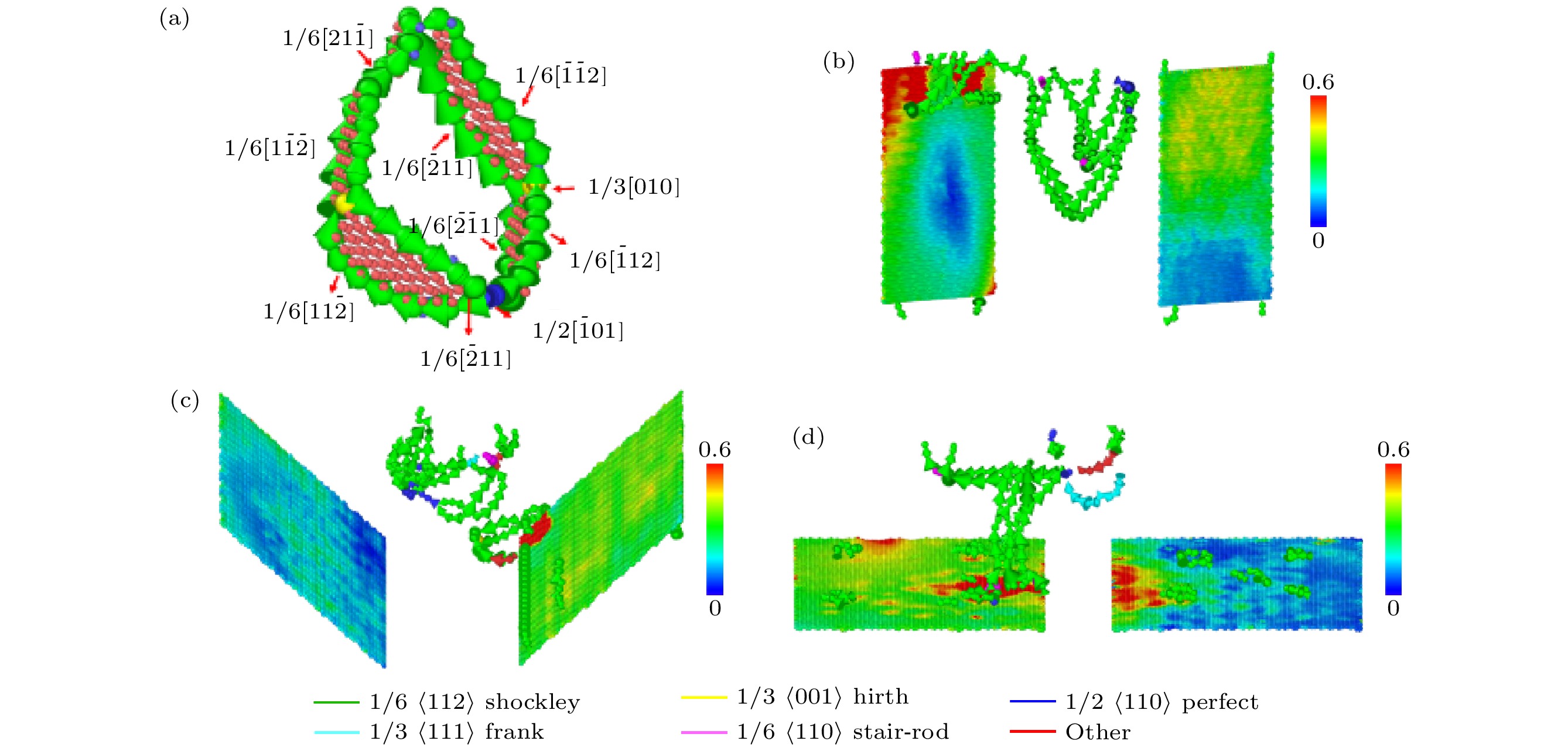-
Graphene has been thought to be an ideal reinforcement material for metal matrix composite due to its superior mechanical properties and unique two-dimensional geometry. However, the deformation mechanism of graphene/aluminum matrix composite is still unclear. In this paper, molecular dynamics simulation is used to elucidate the evolution details of the dislocation microstructure and the underlying interaction behavior between dislocation and graphene during nanoindentation of the graphene/aluminum matrix composite with various graphene orientations. To this end, four different cases, i.e. the pure aluminum and the graphene/aluminum matrix composite with the graphene orientation of 90°, 45° and 0° are examined, respectively. Based on the force-indentation depth curve, the interaction behavior between dislocation and graphene and its effect on the plastic zone are analyzed. The results indicate that the graphene can act as an effective dislocation motion barrier, and the elastic deformation of graphene can occur locally along the direction of dislocation slip. Using the visualization technique of dislocation extraction algorithm, the nucleation and propagation of dislocation are investigated. The results show that the differences in interaction behavior between dislocation and graphene with various orientations affect the spreading trend of the plastic zone and the blocking strength of graphene to dislocation. For the composite with the graphene orientations of 45° and 0°, the interaction between graphene and dislocation causes the number of dislocations to increase. Additionally, the plastic zone of the composite with the graphene orientation of 45° is tangent to two symmetrical graphene sheets. For the composite with the graphene orientation of 90°, the interaction between graphene and dislocation shortens the total length of the dislocation line, and the volume shrinkage of plastic zone is most significant after indenter retraction. Here, the hardness is also calculated to quantitatively evaluate the influence of graphene orientation on the mechanical properties of graphene/aluminum matrix composite. The hardness of the composite with the graphene orientation of 45° is highest, which is due to the decrease of the volume of the plastic zone and the increase of dislocation number. The decrease of the hardness of the composite with the graphene orientation of 90° is attributed to the reduction of dislocation number in the plastic zone. However, for the composite with the graphene orientation of 0°, the interaction between graphene and dislocation results in the softening effect, because of a wide range of elastic deformation in the graphene plane. The study can provide a certain theoretical guidance for designing and preparing the high-performance graphene/metal matrix composites.
-
Keywords:
- molecular dynamics simulation /
- mechanical property /
- nanoindentation /
- graphene/aluminum matrix composite
[1] Miracle D B 2005 Compos. Sci. Technol. 65 2526
 Google Scholar
Google Scholar
[2] Tjong S C 2013 Mater. Sci. Eng., R 74 281
 Google Scholar
Google Scholar
[3] Novoselov K S, Geim A K, Morozov S V, Jiang D, Zhang Y, Dubonos S V, Grigorieva I V, Firsov A A 2004 Science 306 666
 Google Scholar
Google Scholar
[4] 范冰冰, 郭焕焕, 李稳, 贾瑜, 张锐 2013 物理学报 62 148101
 Google Scholar
Google Scholar
Fan B B, Guo H H, Li W, Jia Y, Zhang R 2013 Acta Phys. Sin. 62 148101
 Google Scholar
Google Scholar
[5] Zhong T, Li J, Zhang K 2019 J. Appl. Phys. 125 175110
 Google Scholar
Google Scholar
[6] Kim Y, Lee J, Yeom M S, Shin J W, Kim H, Cui Y, Kysar J W, Hone J, Jung Y, Jeon S, Han S M 2013 Nat. Commun. 4 2114
 Google Scholar
Google Scholar
[7] Bartolucci S F, Paras J, Rafiee M A, Rafiee J, Lee S, Kapoor D, Koratkar N 2011 Mater. Sci. Eng., A 528 7933
 Google Scholar
Google Scholar
[8] Ovid’ko I A, Sheinerman A G 2014 J. Phys. D: Appl. Phys. 47 495302
 Google Scholar
Google Scholar
[9] Li Z, Guo Q, Li Z, Fan G, Xiong D B, Su Y, Zhang J, Zhang D 2015 Nano Lett. 15 8077
 Google Scholar
Google Scholar
[10] Zhao L, Guo Q, Li Z, Xiong D B, Osovski S, Su Y, Zhang D 2019 Int. J. Plast. 116 265
 Google Scholar
Google Scholar
[11] 马通, 谢红献 2020 物理学报 69 130202
 Google Scholar
Google Scholar
Ma T, Xian H X 2020 Acta Phys. Sin. 69 130202
 Google Scholar
Google Scholar
[12] Lyu G J, Qiao J C, Yao Y, Pelletier J M, Rodney D, Morthomas J, Fusco C 2020 Scr. Mater. 174 39
 Google Scholar
Google Scholar
[13] Zhou X, Bu W, Song S, Sansoz F, Huang X 2019 Mater. Des. 182 108093
 Google Scholar
Google Scholar
[14] Du Y, Zhou Q, Jia Q, Shi Y, Wang H, Wang J 2020 Mater. Res. Lett. 8 357
 Google Scholar
Google Scholar
[15] Charleston J, Agrawal A, Mirzaeifar R 2020 Comput. Mater. Sci. 178 109621
 Google Scholar
Google Scholar
[16] Weng S, Ning H, Fu T, Hu N, Zhao Y, Huang C, Peng X 2018 Sci. Rep. 8 3089
 Google Scholar
Google Scholar
[17] Shuang F, Aifantis K E 2020 Scr. Mater. 181 70
 Google Scholar
Google Scholar
[18] Plimpton S 1995 J. Comput. Phys. 117 1
 Google Scholar
Google Scholar
[19] Zha X H, Zhang R Q, Lin Z 2014 J. Chem. Phys. 141 064705
 Google Scholar
Google Scholar
[20] Lee Y, Park J Y, Kim S Y, Jun S, Im S 2005 Mech. Mater. 37 1035
 Google Scholar
Google Scholar
[21] Mishin Y, Farkas D, Mehl M J, Papaconstantopoulos D A 1999 Phys. Rev. B 59 3393
 Google Scholar
Google Scholar
[22] Stuart S J, Tutein A B, Harrison J A 2000 J. Chem. Phys. 112 6472
 Google Scholar
Google Scholar
[23] Silvestre N, Faria B, Canongia Lopes J N 2014 Compos. Sci. Technol. 90 16
 Google Scholar
Google Scholar
[24] Zhou X, Liu X, Lei J, Yang Q 2020 Comput. Mater. Sci. 172 109342
 Google Scholar
Google Scholar
[25] Stukowski A 2010 Model. Simul. Mater. Sci. Eng. 18 015012
 Google Scholar
Google Scholar
[26] Faken D, Jónsson H 1994 Comput. Mater. Sci. 2 279
 Google Scholar
Google Scholar
[27] Stukowski A, Bulatov V V, Arsenlis A 2012 Model. Simul. Mater. Sci. Eng. 20 085007
 Google Scholar
Google Scholar
[28] Remington T P, Ruestes C J, Bringa E M, Remington B A, Lu C H, Kad B, Meyers M A 2014 Acta Mater. 78 378
 Google Scholar
Google Scholar
[29] Jiao S, Tu W, Zhang P, Zhang W, Qin L, Sun Z, Chen J 2018 Comput. Mater. Sci. 143 384
 Google Scholar
Google Scholar
[30] Chang S W, Nair A K, Buehler M J 2013 Philos. Mag. Lett. 93 196
 Google Scholar
Google Scholar
[31] Mortazavi B, Rémond Y, Ahzi S, Toniazzo V 2012 Comput. Mater. Sci. 53 298
 Google Scholar
Google Scholar
[32] Gao Y, Ruestes C J, Tramontina D R, Urbassek H M 2015 J. Mech. Phys. Solids 75 58
 Google Scholar
Google Scholar
[33] 李锐, 刘腾, 陈翔, 陈思聪, 符义红, 刘琳 2018 物理学报 67 190202
 Google Scholar
Google Scholar
Li R, Liu T, Chen X, Chen S C, Fu Y H, Liu L 2018 Acta Phys. Sin. 67 190202
 Google Scholar
Google Scholar
[34] Taylor G I 1934 Proc. R. Soc. London, Ser. A 145 388
 Google Scholar
Google Scholar
[35] Bagheripoor M, Klassen R 2020 Mech. Mater. 143 103311
 Google Scholar
Google Scholar
[36] Vardanyan V H, Urbassek H M 2019 Comput. Mater. Sci. 170 109158
 Google Scholar
Google Scholar
-
图 1 (a)纯铝的初始模型; 石墨烯的嵌入方位分别为(b) 90°, (c) 45°和(d) 0°的Gr/Al复合材料的初始模型, 其中蓝色原子为对称的石墨烯片, 绿色原子为铝基体
Figure 1. (a) Initial model of the pure Al; initial model of the Gr/Al composites with graphene orientations of (b) 90°, (c) 45°, and (d) 0°, where blue atoms represent symmetrical graphene sheets and green atoms are Al matrix.
图 4 (a)棱柱形位错环的原子结构图; (b)—(d) Gr/Al复合材料在石墨烯嵌入位向分别为(b) 90°, (c) 45°和(d) 0°, 压痕深度分别为(b) 1.75 nm, (c) 1.59 nm和(d) 1.59 nm时的位错线分布和石墨烯的表面起伏情况
Figure 4. (a) Atomic snapshot of prismatic dislocation loop; (b)–(d) dislocation line distribution of Gr/Al composites and in-plane height profile of graphene at the indentation depth of (b) 1.75 nm, (c) 1.59 nm, and (d) 1.59 nm, with graphene orientations of (b) 90°, (c) 45°, and (d) 0°.
图 5 (a)卸载过程中, 纯铝和Gr/Al复合材料的压痕力与压痕深度的关系; (b) 卸载过程中, 纯铝和Gr/Al复合材料的总位错线长度的演化
Figure 5. (a) Relationship between indentation force and indentation depth of the pure Al and the Gr/Al composites during the unloading stage; (b) evolution of total dislocation length of the pure Al and the Gr/Al composites during the unloading stage.
-
[1] Miracle D B 2005 Compos. Sci. Technol. 65 2526
 Google Scholar
Google Scholar
[2] Tjong S C 2013 Mater. Sci. Eng., R 74 281
 Google Scholar
Google Scholar
[3] Novoselov K S, Geim A K, Morozov S V, Jiang D, Zhang Y, Dubonos S V, Grigorieva I V, Firsov A A 2004 Science 306 666
 Google Scholar
Google Scholar
[4] 范冰冰, 郭焕焕, 李稳, 贾瑜, 张锐 2013 物理学报 62 148101
 Google Scholar
Google Scholar
Fan B B, Guo H H, Li W, Jia Y, Zhang R 2013 Acta Phys. Sin. 62 148101
 Google Scholar
Google Scholar
[5] Zhong T, Li J, Zhang K 2019 J. Appl. Phys. 125 175110
 Google Scholar
Google Scholar
[6] Kim Y, Lee J, Yeom M S, Shin J W, Kim H, Cui Y, Kysar J W, Hone J, Jung Y, Jeon S, Han S M 2013 Nat. Commun. 4 2114
 Google Scholar
Google Scholar
[7] Bartolucci S F, Paras J, Rafiee M A, Rafiee J, Lee S, Kapoor D, Koratkar N 2011 Mater. Sci. Eng., A 528 7933
 Google Scholar
Google Scholar
[8] Ovid’ko I A, Sheinerman A G 2014 J. Phys. D: Appl. Phys. 47 495302
 Google Scholar
Google Scholar
[9] Li Z, Guo Q, Li Z, Fan G, Xiong D B, Su Y, Zhang J, Zhang D 2015 Nano Lett. 15 8077
 Google Scholar
Google Scholar
[10] Zhao L, Guo Q, Li Z, Xiong D B, Osovski S, Su Y, Zhang D 2019 Int. J. Plast. 116 265
 Google Scholar
Google Scholar
[11] 马通, 谢红献 2020 物理学报 69 130202
 Google Scholar
Google Scholar
Ma T, Xian H X 2020 Acta Phys. Sin. 69 130202
 Google Scholar
Google Scholar
[12] Lyu G J, Qiao J C, Yao Y, Pelletier J M, Rodney D, Morthomas J, Fusco C 2020 Scr. Mater. 174 39
 Google Scholar
Google Scholar
[13] Zhou X, Bu W, Song S, Sansoz F, Huang X 2019 Mater. Des. 182 108093
 Google Scholar
Google Scholar
[14] Du Y, Zhou Q, Jia Q, Shi Y, Wang H, Wang J 2020 Mater. Res. Lett. 8 357
 Google Scholar
Google Scholar
[15] Charleston J, Agrawal A, Mirzaeifar R 2020 Comput. Mater. Sci. 178 109621
 Google Scholar
Google Scholar
[16] Weng S, Ning H, Fu T, Hu N, Zhao Y, Huang C, Peng X 2018 Sci. Rep. 8 3089
 Google Scholar
Google Scholar
[17] Shuang F, Aifantis K E 2020 Scr. Mater. 181 70
 Google Scholar
Google Scholar
[18] Plimpton S 1995 J. Comput. Phys. 117 1
 Google Scholar
Google Scholar
[19] Zha X H, Zhang R Q, Lin Z 2014 J. Chem. Phys. 141 064705
 Google Scholar
Google Scholar
[20] Lee Y, Park J Y, Kim S Y, Jun S, Im S 2005 Mech. Mater. 37 1035
 Google Scholar
Google Scholar
[21] Mishin Y, Farkas D, Mehl M J, Papaconstantopoulos D A 1999 Phys. Rev. B 59 3393
 Google Scholar
Google Scholar
[22] Stuart S J, Tutein A B, Harrison J A 2000 J. Chem. Phys. 112 6472
 Google Scholar
Google Scholar
[23] Silvestre N, Faria B, Canongia Lopes J N 2014 Compos. Sci. Technol. 90 16
 Google Scholar
Google Scholar
[24] Zhou X, Liu X, Lei J, Yang Q 2020 Comput. Mater. Sci. 172 109342
 Google Scholar
Google Scholar
[25] Stukowski A 2010 Model. Simul. Mater. Sci. Eng. 18 015012
 Google Scholar
Google Scholar
[26] Faken D, Jónsson H 1994 Comput. Mater. Sci. 2 279
 Google Scholar
Google Scholar
[27] Stukowski A, Bulatov V V, Arsenlis A 2012 Model. Simul. Mater. Sci. Eng. 20 085007
 Google Scholar
Google Scholar
[28] Remington T P, Ruestes C J, Bringa E M, Remington B A, Lu C H, Kad B, Meyers M A 2014 Acta Mater. 78 378
 Google Scholar
Google Scholar
[29] Jiao S, Tu W, Zhang P, Zhang W, Qin L, Sun Z, Chen J 2018 Comput. Mater. Sci. 143 384
 Google Scholar
Google Scholar
[30] Chang S W, Nair A K, Buehler M J 2013 Philos. Mag. Lett. 93 196
 Google Scholar
Google Scholar
[31] Mortazavi B, Rémond Y, Ahzi S, Toniazzo V 2012 Comput. Mater. Sci. 53 298
 Google Scholar
Google Scholar
[32] Gao Y, Ruestes C J, Tramontina D R, Urbassek H M 2015 J. Mech. Phys. Solids 75 58
 Google Scholar
Google Scholar
[33] 李锐, 刘腾, 陈翔, 陈思聪, 符义红, 刘琳 2018 物理学报 67 190202
 Google Scholar
Google Scholar
Li R, Liu T, Chen X, Chen S C, Fu Y H, Liu L 2018 Acta Phys. Sin. 67 190202
 Google Scholar
Google Scholar
[34] Taylor G I 1934 Proc. R. Soc. London, Ser. A 145 388
 Google Scholar
Google Scholar
[35] Bagheripoor M, Klassen R 2020 Mech. Mater. 143 103311
 Google Scholar
Google Scholar
[36] Vardanyan V H, Urbassek H M 2019 Comput. Mater. Sci. 170 109158
 Google Scholar
Google Scholar
Catalog
Metrics
- Abstract views: 10274
- PDF Downloads: 193
- Cited By: 0















 DownLoad:
DownLoad:







